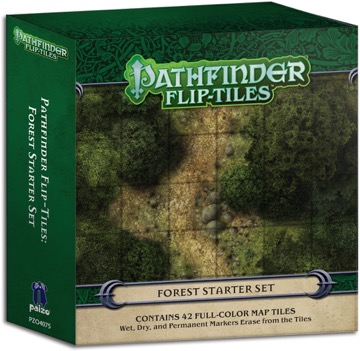Not too long ago we announced a change to our modular mapping products. Pathfinder Map Packs had a good run, but we knew we could do better. To replace the Map Packs, we put together Flip-Tiles: 6-inch-by-6-inch, double-sided tiles, each corresponding to a themed starter set, and designed to be even more modular than the Map Packs where.
Our first Starter Set along with its first expansion saw announcement in that earlier blog. Surprise, surprise, it was dungeon themed. After the release of those two sets, we are going to release the second starter, which will be Forest Starter Set. Coming quickly on its heels is a forest-themed expansion, similar to the role that Dungeon Perils plays with the Dungeon Starter Set. From these two initial starter sets and their expansions, you can see where we are going with all of this. Given that many of the sets also have connector tiles—that is tiles that bridge the gap between one theme and another, you can probably get a good idea of where the product line is going.
Not everything is set in stone, though. As with any new product, we are keen to assess your wants and desires for such products. I'm pretty good at anticipating, since my first thought when designing a new map or a mapping product is always, "would I want to play with this?" But sometimes something incredibly obvious can just zing over my head as I sketch away on this project or that.
In one of those "why the heck didn't I think of that?" moments, when we announced the product in an earlier blog, a group of folks suggested that we find an alphanumeric scheme for the tiles. It was a good idea and sent us backpedaling a bit and considering the best way to implement such a feature.
Like any product decision, this starts with a cost/benefit analysis, not one that talked to the bottom line when it comes to the actual economics of the product. It wouldn't affect the printing costs, but would such numbering be beneficial rather than harmful. The benefits were numerous. Not only would it help the user organize their collection, but such a code can also be utilized by adventure writers to instantly tell the user what tiles were needed to present a map that used them and even which set to find the correct tile.
It's no secret that an element for the success of the Pathfinder Flip-Mat Classics line is Pathfinder Society's has utilization of Flip-Mats throughout that line and the older GameMastery lines' existence. It turns out that when actual use and play increases so does demand. One of the goals of the Flip-Tile line was an increase of utility with of modular mapping product, so any idea that would improve that usability carried a great deal of weight.
Of course, as with anything, there were arguments against organizing the tiles with an alphanumeric code. But they were sparse, typically amounted to the complaint that it would "reduce immersion," so we knew that if we could make it as useful and unobtrusive as possible, we could hover around the best of both worlds.
In the end, after a great deal of brainstorming and discussion, we came up the with the following format:
[Two letter abbreviation for set] [Set number]
[Tile number] [Side A or B]
The abbreviation for the set type tells you what starter set the tile is from or expands. For instance, if the tile is part of the Dungeon Starter Set or one of its expansions, it features the letters DU (for dungeon). If its part of the Forest Starter Set or one of the forest expansions, it features the letter FR (for forest... while avoiding the somewhat confusing FO designator). The set numbering is as brief and concise as possible. If the tile is from a starter set, the set number is 0. Since Dungeon Perils is the first expansion of the Dungeon Starter Set, that set's tiles will feature a DU1 in the first line of the code.
There is a tile number from 01-42 for in each starter set or 01-24 in each expansion. One side is labeled A, and the other is labeled B. So, for instance, the second side of the 24th tile in Flip-Tiles: Dungeon Perils would have the following code featured on a corner of the tile.
DU1
24B
While the last second side of the last tile found in Flip-Tiles: Forest Starter Set would feature this code.
FR0
42B
With just a glance, you can put away and rearrange your tiles. Better yet, when preparing your next game, you can just list the group of tiles you need for each encounter, throw them in a box and go.
All of this stems our main goal here at Paizo—to give you all the content and tools to have the best roleplaying experiences available.
Stephen Radney-MacFarland
Senior Designer

